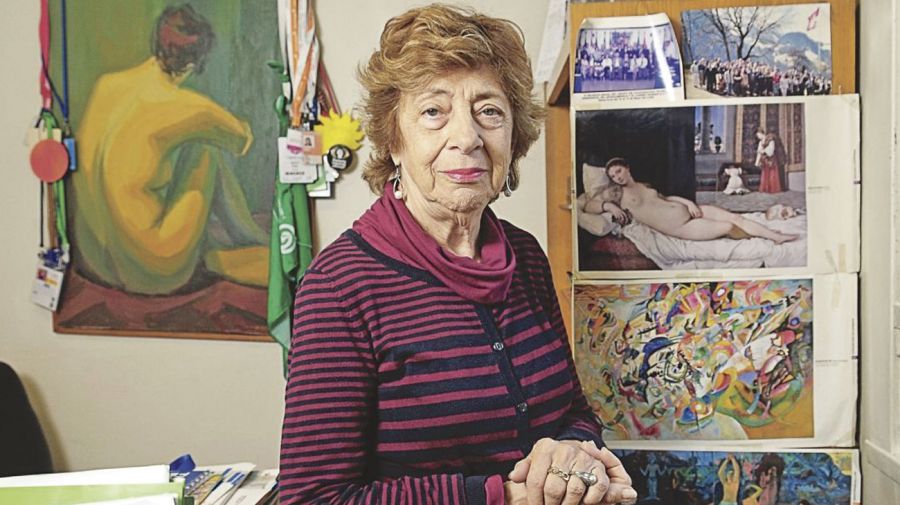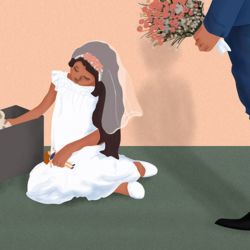In some Argentine provinces, a girl’s first menstruation does not symbolise a welcome to adolescence or fertility. It marks a critical moment to go on the alert.
In the northern province of Misiones, for example, a girl of 12 – whose name is not revealed here to preserve her privacy – began to become an object of desire for local (and also visiting) males. The girl’s parents handed her over in marriage to a local notable figure much older than herself, in order to protect her from others hoping to abuse her. Now that the girl is married, local males in the region do not approach her because they respect her husband. The parents have thus guarded their daughter from external abuse while converting the adolescent into the victim of abuse by her own husband.
This sequence is repeated over and over again and not just in Bangladesh, India or Pakistan. One could imagine child marriage to be something that happens far away and long ago, commonly linked to Oriental or African communities, but this reality is closer than one might think.
In the aforementioned Misiones, 7.2 percent of underage girls are married. In the province of Chaco, it’s 6.9 percent. In Formosa, 6.4 percent. In absolute terms, Buenos Aires Province heads the list with the most child brides. Every province has child marriages with greater or lower percentages. Every department in Misiones, Chaco and Formosa presents a high percentage of wedded infants.
Across the country
In Argentina, 4.7 percent of girls marry or enter into common-law relationships before reaching the age of 18. That’s a total of 132,398 adolescents in the 14 to 18 age-group nationwide.
The greatest frequency is found in the northeastern region (Chaco, Corrientes, Formosa and Misiones), followed by the Northwest, Central Argentina and Patagonia. Other provinces topping the national average include Santa Fe and Entre Ríos (both with 5.4 percent), Corrientes and Santiago del Estero (5.3 percent each), Salta (five percent) and La Rioja (4.9 percent).
The data comes from a recent report presented by Fundación para el Estudio e Investigación de la Mujer (Foundation for the Study and Research on Women, FEIM), an organisation set up in 1989 and headed by the doctor and activist Mabel Bianco.
The study, El trabajo, El matrimonio y las uniones convivenciales infantiles en Argentina (“Work, Marriage and Child Cohabitation in Argentina”), is backed by a United Nations fund that seeks to eliminate violence against women. It is a unique production – pre-existing information on child marriages is fragmented and sporadic, hence the importance of the figures and testimony contained within the report.
There are no antecedents for statistics on this issue in Argentina – this is the first time that such a database has been constructed when both age and cohabitation are data which could have been construed from the national censuses.
This study, directed by Bianco and Cecilia Correa (a psychology graduate with a masters in Society, Gender and Public Policy), analysed the data of girls and adolescents in the 14 to 17 age-group and whether they are married or living in common-law partnerships. Studying each province and using data from the 2010 National Census (data from last year’s edition is not yet ready), the researchers paid particular attention to Question #24: Are you living with anybody in common-law or marital partnership?
Child marriage is always forced. The underaged are too young to be psychologically prepared to take a conscious and informed decision. Among the consequences of such a decision are the right to an education, sexual rights, the possibility of a choice and living a life without violence and the capacity for economic self-sufficiency have all been violated.
Marriages are not always formalised before the civil authorities; indeed in most cases the unions are informal or celebrated in traditional ceremonies with no records kept, which makes them difficult to quantify.
In Greater Buenos Aires there are no marriages observed officially but there are unions which are even worse since they are not permitted by legislation and thus no data appears anywhere, explains Bianco.
Child marriage is almost twice as frequent in rural zones with girls living in poverty and those from indigenous groups particularly at risk.

Gender violence
Latin America and the Caribbean is the continent with the third-highest percentage of wedded children, lagging only behind Africa and Asia – across the region, a quarter of all females marry before they are 18, equivalent to over 82 million girls.
In the last 10 years child marriage has diminished worldwide, with the exception of this region. The United Nations’ Convention of the Rights of the Child recognises that infant unions affect girls more and are thus a form of gender violence.
Buenos Aires Province, Argentina’s most-populous district, has a low percentage when measured against its inhabitants but it tops the list in absolute numbers with 49,510 underage girls married. It also leads in the category of mothers aged between 15 and 19 living in common-law partnership with 83,228 cases.
The nation’s capital, Buenos Aires City, has the lowest percentage of child marriage at 2.3 percent. Breaking down the figures even further, the department of Ramón Lista in Formosa (where over 80 percent of the population is indigenous, mostly Wichi) has the highest at 15.4 percent, double the provincial average. This area, along with Bermejo (Formosa), Rivadavia (Salta) and Tapenagá (Chaco) together constitute the zone known as ‘El Impenetrable,’ an underpopulated area mostly inhabited by the indigenous Qom and Wichi peoples.
In Ramón Lista, specifically in the locality of El Potrillo, primary school teacher Betty has broken with the family tradition. Her mother and grandmother both married young, but the educator has chosen a different path: she runs a workshop for the intergenerational discussion of this issue.
“Here girls linking up with adult males is considered normal and has been for a long time. When you talk to the girls about ‘abuse,’ they are surprised. They join up obliged by pregnancy or their families, [it’s]not just the parents because in our culture the whole family is involved,” explains Betty.
“These girls have their dreams in life. Some are illiterate and want to study so as not to be like the others who marry. We are recently in the stage of talking through this issue but they tell you: ‘If everybody does it…’”
Betty has asked for her surname not to appear in this article. “I like to help others. [But] I don’t want to feel afraid, I’m accompanied by other women.”
Laws and treaties
In Formosa, an adolescent becomes pregnant. She follows the usual course of things, agreeing when the much older father of the future baby decides that it is time to start living together. She is 16, while her husband is 50, something not punishable by Argentine law. Such circumstances are repeated nationwide.
“I’m pregnant so my mum and dad made my husband responsible,” says one child in one of the report’s testimonies.
Argentina has signed many international treaties condemning child marriage and there are even local laws denouncing it, directly or indirectly.
Law 25,673 governing sexual and reproductive health speaks of free decision-making, the prevention of unwanted pregnancies and the care of adolescents, along with Law 26,061 for the Integral Protection of the Rights of Children and Adolescents and Law 26,485 “to prevent, sanction and eradicate violence against women,” just to name a few.
Nevertheless, all this legislation does not seem enough to prevent the practice from existing. Law 2,393 governing civil marriage prohibits the union of females aged under 12 and males aged under 14 (Article 9). This age-range is decisive in the life of young girls – not only does her adolescence begin but also the possibility of contracting marriage.
Nevertheless, Article 10 of that law establishes: “Females aged over 12 and males aged over 14, but not reaching adulthood, and deaf-mutes who cannot express themselves in writing, may not wed each other nor other people without the consent of their father, mother or guardian if there are no parents.”
Not only should it be stressed that there is no equality within parental consent, since the father takes priority, but what happens if it is the parents who are authorising and encouraging this union? Many cases of child marriages are sought and authorised by the older generation. There is a need to look into the motives driving such a decision.
“The mothers tell us that once their daughters reach a certain age, between 13 and 14, they catch the eye of passersby coming and going from Brazil. The girls are chased and abused and if they become pregnant, there is nobody to take responsibility,” Bianco explained in an interview. “You see the pregnancy but not what lies behind it – that is one of the reasons why it is a hidden issue. The women believe that in these cases it is preferable for it to be known in the community that the girl has a male to protect her. And when the men of the community know that the girl is living with somebody, they respect the husband although not the girl.”
Consulted as to whether the idea behind this logic is to privilege the girl being abused by a single man in her home and not by many in the street, Bianco replied: “That’s the idea. The mothers tell you: ‘We prefer them to join up.’ They did the same thing themselves, as a form of protection against being raped. After marriage their panoramas are cut short and none of the girls continue studying, they become servants in the house of their masters.”
“We don’t want to transmit the message that the girls should not marry but rather that if they do, it is a decision taken by themselves which they want. Most of these marriages come with a pregnancy, dropping out of school and the issue of childcare – the girls not only look after their own children but those of their adult partners along with all the housework,” adds Correa.

Risk factors
The other unspoken factor here is equality of opportunity, specifically when it comes to economic matters.
“In Chaco, a girl is born and lives in poverty all her life. Her family has been marginal for decades. They have no drinking water or decent housing. The possibility of the girl marrying a man who lives better is the only chance the family has to break the generational poverty chain,” says Bianco. “Her parents arrange a marriage as their only possibility of social mobility, as a form of having a better economic life. The logic here is not, at least in some cases, selling off the girl but handing her over with the purpose, good or bad, that tomorrow she has a better life.”
She continues: “We have found in some places that some mothers send their daughters off to the market alone at the age of 13 in the hope that some man sees them. That’s where the economic factor comes in. It’s not something which only happens among the poor but money can cover it up.”
One of FEIM’s recent innovations has been the creation of an Index for the Prediction of the Risks of Early Unions in Households, which considers the indicators which provoke greater or lesser risk of child marriages. These include the nuptial history (which refers to the ascendency of early marriages in the mothers of girls and adolescents), naturalisation of the prospect within the family, a child’s educational history (which seeks to ascertain the years of schooling and the dropouts), and lastly, the indicator of structural poverty and destitution. In the latter case, these unions are a way out of marginal life.
The result places 48 percent of the households in Misiones, 42 percent in Formosa and 64 percent in this city at medium risk. In Formosa 34 percent of homes are at high risk (seven percent in Misiones) and 16 percent face critical risk.
Finally, it is also important to highlight the relationship between child unions and violence. Almost half (46 percent) of wedded girls aged 18 or under suffer violence in their relationship. Denunciations of gender violence double for every year the adolescent adds to her age – at 16 some 12 percent suffer violence and at age 17, the percentage rises to 29 percent.
There remains much work to be done, but with the help of FEIM, the issue is now at long last on the table.
“This project is the first great step towards making child marriages visible in Argentina,” affirms Correa.





















Comments